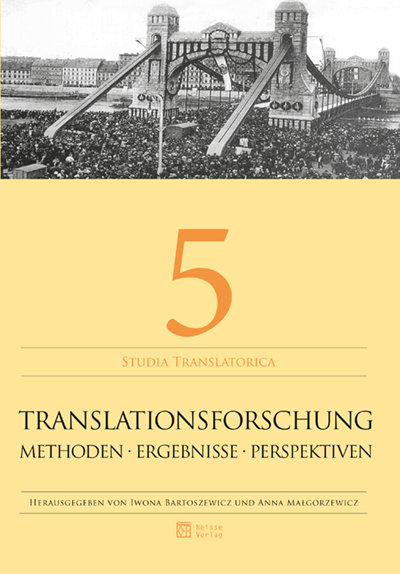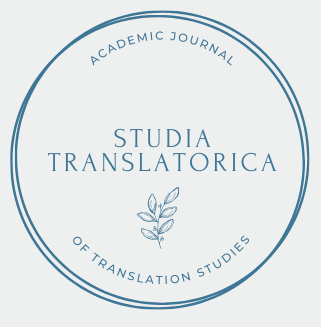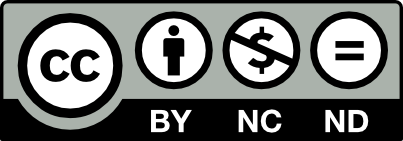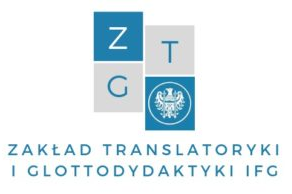
Studia Translatorica
Issue 5 (2014): Translationsforschung. Methoden, Ergebnisse, Perspektiven
Edited by: Iwona Bartoszewicz and Anna Małgorzewicz
Implikation statt Äquivalenz? Anmerkungen zu einem Vorschlag / Implication instead of equivalence? Comments on a proposal
DOI: --- (published online: 2020-10-18)
Keywords: translation theory, equivalence, implication, reversibility vs. irreversibility, process vs. product
This paper discusses a proposal made by Holger Siever in the context of his Habilitationsschrift (2010). Siever proposes to replace the term ‘equivalence’ in the context of translation studies with the term ‘implication’. He argues that the concept of equivalence refers to a reversible relation while the concept of implication is, by definition, irreversible. After discussing some terminological and methodological advantages and disadvantages of Siever’s proposal, the paper concludes that the two concepts can be compatible if one combines a process-oriented and a product-oriented perspective on translation.
Das Problem der Subjektivität bei der Beurteilung von Übersetzungen / The problem of subjectivity in translation quality assessement
DOI: --- (published online: 2020-10-18)
Keywords: translation, quality, assessment, subjectivity, objectivity
The present essay examines how subjectivity affects the assessment of quality in translated texts. On the basis of philosophical approaches, we regard the subjective and objective not as two mutually exclusive concepts but as the extreme positions on a cline with an infinite number of positions in between. In translation quality assessment, the subjective cannot be fully eliminated. It can at best be reduced to a minimum. This can be achieved through a clearly defined system of assessment parameters, empirical approaches such as corpus analysis, and quantification.
Pole terminologiczne jako instrument konfrontacji leksyki prawnej dla celów leksykograficznych i translacyjnych / Terminological area as an instrument of legal lexis confrontation for lexicography and translation purposes
DOI: --- (published online: 2020-10-18)
Keywords: terminological equivalence, law and legal terminology, methodology of comparative studies, comparison of legal systems
The article focuses on issues referring to the terminological equivalents occurring in the two separate legal systems. To describe the issue the following terminological field has been explored: juvenile, minor, and their German equivalents, as well as the inclusion and analysis of these terms in the bilingual specialist dictionary. The study involves the evaluation of the correctness of the proposed terms from a legal standpoint, and methodological assumptions to be included by lexicographers and translators in this area.
Błąd krytyczny w tłumaczeniach poświadczonych / Fatal Errors in Certified Translations
DOI: --- (published online: 2020-10-18)
Keywords: translation studies, sworn translator, certified translation, translation error, fatal error
The author discusses the category of a fatal error in certified translations. In the first part of the article, he defines a translation error and presents in short the classifications of translation errors worked out by Polish and German linguists. Next he defines a fatal error for the purpose of the article and describes the types of fatal errors. In the second part of the article, he presents several examples which may be considered fatal errors taken from translations made by sworn translators or candidates for sworn translators and from his own translation practice. He also discusses fatal errors widely publicized in the media.
Die Verwendung der Wortfeldmengentheorie in der Beschreibung der künstlerischen Übersetzung am Beispiel der Dichtung Jan Twardowskis und ihrer Übersetzungen ins Polnische / The application of semantic-fi eld-set-theory to describe artistic translations on the example of Jan Twardowski poems and their German renditions
DOI: --- (published online: 2020-10-18)
Keywords: semantic-field-set-theory, translation theory, poetry translation
The author attempts to describe the translation possibilities of the nominal phrases in the poetry by Jan Twardowski. His semantic-set-theory is used for this purpose, which is based on semantic-fields-theory by Edward Balcerzan. The translation procedure is described here as operating on two or more semantic fields, to which common parts the translator relates to. With the help the symbols used for notation of logical relations and mathematical operations the author presents the way of a schematic notation of translation decisions and the translation possibilities in the translation process.
Riflessioni sulle future prospettive dell’arte del tradurre / Reflections over the Future Perspectives of the Craft of Translation
DOI: --- (published online: 2020-10-18)
Keywords: translation, perspectives, approaches, developments
Translations have been cultivated throughout the centuries, from the Greeks through the Romans to our modern times. Each age has produced its own perspectives on the art of translation, and the respective translators have imprinted their interpretive approaches on the nature of their translations, approaches that also reflect the cultural and anthropological orientation of their times. The present article offers a critical assessment of recent developments in the young discipline of Translation Studies and sets out to provide an answer, as seen from a European perspective today. The aim of this paper is to stimulate discussion and provoke further debate on the current profile and future perspectives of the craft of translation.
Screen Translation: Quality through Transparency, Democratisation and Openness to Science? / Screen Translation: Quality through Transparency, Democratisation and Openness to Science?
DOI: --- (published online: 2020-10-18)
Keywords: translation quality, screen translation, linguistics, digitalisation, socio-economics, history of translation
Screen translation is a field that historically has seldom explicitly addressed the issue of translation quality, be it in terms of translation studies or translation practice. This is mainly due to oligopolistic, non-transparent and non-democratic tendencies during the historical establishment of the sub-types of and practices in screen translation, i.e. socio-economic factors. This historical development has led to the neglect of key TQ factors: linguistics and linguistic skills. Recent tendencies towards more openness, transparency, and democratic principles, in part due to digitalisation, give reason to expect increased pressure to achieve high translation quality, as well as openness to translation studies, and a reassertion of scientific principles as far as translation studies itself is concerned
Beiträge neurowissenschaftlicher Studien zur Translationswissenschaft / Neuroscientifi c contributions to translation studies
DOI: --- (published online: 2020-10-18)
Keywords: neurosciences, fMRI, aphasia
To find out what happens in the translator’s mind has always been one of the central questions of translation studies. The present paper gives an overview over the theoretical developments which preceded the introduction of the cognitive psychology paradigm in translation studies before situating them within the set of other possible research approaches dedicated to the study of the mind. Neuroimagery is one of these. In particular, this paper argues that functional magnetic resonance imagery (fMRI) is suited to address research questions in translation studies and presents first answers to those.
Waldemar Kania und Krzysztof Lipiński. Oder: Wie der polnische Aphorismus übersetzt wird? / Waldemar Kania and Krzysztof Lipiński. How to translate Polish aphorisms into German
DOI: --- (published online: 2020-10-18)
Keywords: aphorism translation, indirect (non-literal) translation, direct (literal) translation
The paper discusses the translation of the little known and recently deceased Polish aphorism writer Stanisław Kania by the translator and translation theorist Krzysztof Lipiński. It poses the question of proper aphorism translating strategies. The main features of aphorism as well as the resemblance of the texts under study to other authors’ aphorisms have been indicated. The individual character of Lipiński’s choices in the translation has been emphasized. The paper also illustrates his creativity and points to the cases in which direct (literal) translation is justified.
Chamissos Schlemihl (1813) erstmals in Arabisch. Deutsch-Arabische Sprachtranslation am Beispiel der Übersetzung von deutschen Archaismen ins Arabische / Chamisso’s Schlemihl (1813) for the fi rst time in Arabic. German-Arabic Language Translation based on Translating German archaism into Arabic
DOI: --- (published online: 2020-10-18)
Keywords: Adelbert von Chamisso, Peter Schlemihl, Arabic Translation, German archaism, equivalence
This paper discusses the problem of translating German Archaism into Arabic. It’s based on my own experience of translating the fairy tale »The wonderful history of Peter Schlemihl« (1813) by Adelbert von Chamisso from German into Arabic. I have chosen three nouns: ‘Rock’, ‘Herrin’, ‘Kleinodien’; three verbs: ‘däuchen’, ‘sich abhärmen’, ‘zeucheln’; three adjectives: ‘ächt’, ‘darbend’, ‘abgefeimt’ and two interjection: ‘Topp!’, ‘Ei, ei!’ as examples of my attempt to achieve the most possible equivalent translation of German archaism into Arabic.
„‘Two and a half’ Titel”. Ein chrematonischer Beitrag zur Titelübersetzung in der Fernsehindustrie / „Two and a half Title“. A chrematonymical contribution to German and Polish translations of movie titles in television business
DOI: --- (published online: 2020-10-18)
Keywords: series titles, translation, film titles, U.S. five largest broadcasting stations, influence of market
This article is a continuation of the research task covering the latest trends in the translation of film titles. The body of research was the series titles offered in the last three seasons by the five largest U.S. television stations (ABC, NBC, CBS, FOX, CW.tv). The study is limited to discussion of translation techniques, strategies and trends in translation. There is proposed a new division of translation techniques. The analysis shows that the dominant technique for developing translated titles in Germany is borrowings, and in Poland it is translation (syntagmatic, synonymous, literal) and its variations.
Übersetzungsprobleme bei Wortbildungskonstruktionen im Prosawerk von Günter Grass / The problems of translating Günter Grass’s prose works on the morphosyntactic level
DOI: --- (published online: 2020-10-18)
Keywords: literary translation, grammatical structures, neologisms and nonce words, translation techniques, translator’s creativity
The paper deals with selected aspects of literary translation including the translation of grammatical structures. Some problems arising from translating Günter Grass’s prose on the morphosyntactic level constitute the basis for the present discussion. The analytic part consists of a review and a description of the translation techniques applied by Sławomir Błaut in his translation of neologisms and nonce words into Polish.
Strider, Streicher i Łazik. Specyfika przekładoznawczej analizy literackich nazw własnych w obrębie różnych par językowych / Strider, Streicher and Łazik. Specifi c translation analysis of names in the literature in various language pairs
DOI: --- (published online: 2020-10-18)
Keywords: literary proper names, translation of names, various language pairs
The present article undertakes the task of research in the field of literary onomastics in translation. We try to demonstrate differences in translation of proper names from English to German and Polish. The analyzed body comes from the work by J.R.R. Tolkien “The Lord of the Rings”. The analysis concerns 380 names in five available translations – two into German, and three into Polish. German translators have an easier task. Achieving semantic and structural similarity is much easier in related Germanic languages. Polish translators often borrow lexemes. The literal and syntagmatic translations by Jerzy Łoziński (expressing the strategy of domestication) are very interesting from the point of view of translation studies but not positively received by readers.
Übersetzung im Bereich der Kulinaristik – Kulinarien als Stiefkind der Translationstheorie und Translationspraxis / Translation and culinary studies – culinary names as the „stepchildren“ of translation theory and practice
DOI: --- (published online: 2020-10-18)
Keywords: culinary studies, translation, translation theory, translation practice
Culinary names constitute an inseparable element of every person’s life. For this reason, they convey information, like realia, entrenched in the culture and tradition of a particular community. On the other hand, however, the linguistic form of culinary names is frequently hardly translatable. They seem to be disregarded by the theory and practice of translation. In this article, we present an overview of texts discussing the translation of culinary names, paying special attention to those concerning the German and Polish languages. We also discuss translation strategies and techniques, which fall within the scope of our study, and furnish them with examples.
Einige Anmerkungen zu Optimierungsmöglichkeiten der Kooperation/ Kommunikation zwischen Übersetzern und polnischen Verfolgungsorganen beim Erledigen von Rechtshilfeersuchen in Strafsachen / A Few Remarks on how to Improve Cooperation/ Communication between Translators and Polish Prosecuting Authorities while Translating Legal Assistance Documents in Criminal Matters
DOI: --- (published online: 2020-10-18)
Keywords: cooperation and communication improvement, sworn translator and interpreter, Polish prosecuting authorities, legal assistance
The article deals with the problem of improving cooperation/ communication between translators and Polish prosecuting authorities while translating legal assistance documents. The author puts forward a hypothesis that this cooperation/ communication is not optimal, which results in a great waste of time and resources, because impeded contact between the prosecutor handling the case (in particular the prosecutor from the District Prosecutor’s Office) and the translator due to the fact that the translator only contacts the Regional Prosecutor’s Office, which is an intermediary in forwarding requests for legal assistance, very often leads to the time-consuming translation of all documents sent to the translator irrespective of their usefulness for the case. On the basis of an order the author received in 2013, he carried out a survey by questionnaire and an interview with the prosecutor handling the case to assess how many of the documents translated were useless and unnecessary. After presenting research results, the author suggests several simple solutions. They should improve cooperation and communication in this regard, contribute to speeding up the proceedings and to saving public funds as well as increase translators’ satisfaction derived from their work for prosecuting authorities.
Theaterübertitelung als Translationshybride – eine Abhandlung über die experimentale Übertitelung des Theaterstücks „Hund, Frau, Mann“ von Sibylle Berg / Overtitling in theatre as a translation-hybrid – a treatise on the experimental overtitling of the Sibylle Berg’s play “Dog, Woman, Man”
DOI: --- (published online: 2020-10-18)
Keywords: theatre translation, overtitling, translation-hybrid, audiovisual/screen translation
Translation in theatre needs to be shown in the context of the audiovisual translation also known as screen translation, where text is a constituent element of the semiotic complex. In the following article it is achieved through the disputation with the categorization introduced by Tomaszkiewicz (2006) based on Jakobson’s classification (1959) of the intralingual, interlingual and intersemiotic translation. In order to realize that theatre translation is an independent area, some similarities and differences among theatre, movie and opera translation are demonstrated. From this compilation comes the unique hybrid-character of the translation in theatre that can be perceived as an intersection of interpreting and translating (cf. Griesel 2007: 14ff). On the basis of this characteristic, an analysis of the experimental overtitling of the Sibylle Berg’s play “Dog, Woman, Man” is conducted. The analysis is the central point of the evaluation which is the last element of the translational process.
Zum Motiv der Nachtigall in Jan Kochanowskis Werk „Treny” und seinen Übersetzungen ins Deutsche und Niederländische / The motif of a nightingale in Jan Kochanowski’s “Treny” and its translations into German and Dutch
DOI: --- (published online: 2020-10-18)
Keywords: poetical cycle, motif, diminutive, threnody
Translating a poetical cycle poses no mean challenge for a translator because of its complexity and recurring motifs. The poet indicates his idea through the formal arrangement in the cycle and the idea can be understood only after reading the whole cycle. This paper presents an analysis of the recurring motif of a nightingale in Jan Kochanowski’s “Treny”, which indicates the cyclical form, and its translations into German and Dutch. The aim of this article is to show how important it is to treat a poetical cycle as a whole, not only to interpret it properly but also to translate it correctly.
Wie ist die Liebe? Eine Analyse der polnischen und zweier deutscher Übersetzungen des „Hoheliedes“ der Liebe / What is the love like? A peer review of one Polish and two German translations of Chapter 13 of the First Epistle to the Corinthians
DOI: --- (published online: 2020-10-18)
Keywords: Bible translation, love, differences, comparison
The Bible is one of the most important books in the world, not only for Christians, but for all people. It is also a great challenge for translators. This paper contains an analysis of one Polish and two German translations of Chapter 13 of the First Epistle to the Corinthians regarding the attributes of the emotion love. The author studies “Biblia Tysiąclecia”, Luther’s translation of the Bible and the new translation done by Berger and Nord, in order to show differences in the translations and in the understanding by average Bible readers.
Die Übertragung von Witzen in der audiovisuellen Übersetzung am Beispiel der Filmserie „Shrek“ / The rendition of jokes in the audio-visual translation on the example of the film series “Shrek”
DOI: --- (published online: 2020-10-18)
Keywords: comedy, joke, audio-visual translation, dubbing
This paper takes as its subject jokes as translation units and proceeds to analyse translation difficulties and strategies illustrated by the examples from the corpus. The chosen utterances, stemming from the film series Shrek and its official German and Polish translations for dubbed versions, exemplify three types of jokes: universal, cultural, and linguistic ones. This study investigates equivalence relations between the elements of the source text and the target text, the translation constraints related to dubbing techniques, as well as the type of the original and rendered jokes.
Hansen-Schirra, Silvia/ Kiraly, Don (Hg.) (2013). „Projekte und Projektionen in der translatorischen Kompetenzentwicklung“ (= Publikationen des Fachbereichs Translations-, Sprach-, und Kulturwissenschaft der Johannes Gutenberg-Universität Mainz in Germersheim, Bd. 61). Frankfurt am Main: Peter Lang Verlag. 313 S.
DOI: --- (published online: 2020-10-18)
Keywords:
Florczak, Jacek (2013). „Tłumaczenia symultaniczne i konsekutywne. Teoria i praktyka”. Warszawa: C.H. Beck. 278 S.
DOI: --- (published online: 2020-10-18)
Keywords:
Szczygłowska, Martyna (2013). „Übersetzungsfehler. Eine kritische Betrachtung aus der Sicht der anthropozenrischen Translatorik“ (=Warschauer Studien zur Germanistik und zur Angewandten Linguistik). Frankfurt am Main u.a.: Peter Lang. 234 S.
DOI: --- (published online: 2020-10-18)
Keywords:
Krein-Kühle, Monika/ Wienen, Ursula/ Krüger, Ralph (Hg.) (2013). „Kölner Konferenz zur Fachtextübersetzung“. Frankfurt am Main: Peter Lang. 268 S.
DOI: --- (published online: 2020-10-18)
Keywords:
Bostrup, Lise/ Jarosz, Józef/ Stręk, Katarzyna (2014). „Dansk-polsk ordbog”. Forlaget Bostrup, København. 495 S.
DOI: --- (published online: 2020-10-18)
Keywords:


